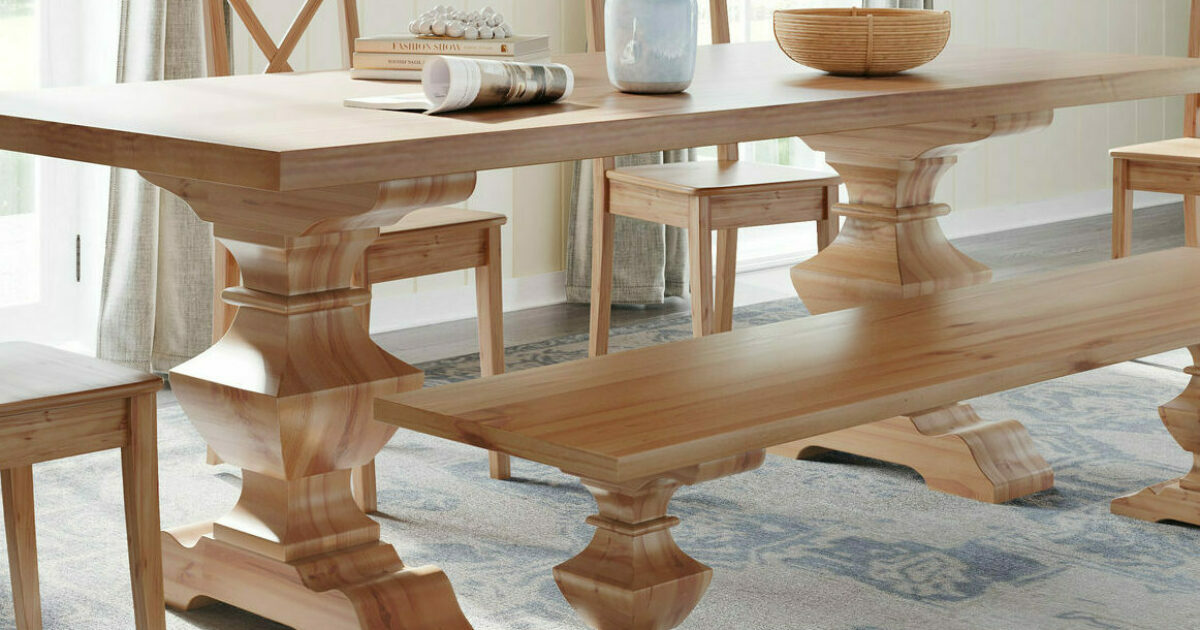Secret Factors to Bear In Mind for Dining Table Legs Timber Choices
When selecting timber for dining table legs, numerous crucial factors require careful consideration to make certain both capability and aesthetic charm. The option of wood type, defined by its sturdiness and special grain patterns, plays a crucial duty in the total layout and longevity of the piece.
Timber Kind and Characteristics
When picking wood for eating table legs, it is vital to recognize the special characteristics of different timber kinds. Different woods offer distinct benefits and downsides, affecting both the durability and visual appeal of the ended up item.
Hardwoods, such as cherry, oak, and maple, are generally liked for their strength and resistance to wear. Oak, known for its excellent longevity, also features a noticeable grain that can add personality to the table. Maple uses a smooth surface and is less prone to warping, making it a trustworthy option for useful furniture. Cherry timber, with its rich shade that grows over time, gives a luxurious look yet might call for even more upkeep to stop scratches.
On the various other hand, softwoods like ache and fir are more budget-friendly and much easier to deal with, yet they are less resilient than woods. Pine is lightweight and features a cozy, rustic look, making it a popular selection for casual dining setups. However, it is extra at risk to scratches and dents.
Recognizing these qualities will certainly assist in making an informed decision to make certain the legs of the dining table meet both practical and aesthetic demands.
Grain Patterns and Aesthetics
The wood's grain is not just an aesthetic feature; it imparts a distinct personality and appeal to each item. Different timber species display unique grain patterns, varying from the straight lines of maple to the intricate swirls of oak and the striking number of walnut.
Furthermore, the orientation and scale of the grain can affect the regarded dimension and beauty of the table. Larger, much more noticable grains might lend a strong, remarkable impact, while finer, subtler grains can create a refined, underrated look. In addition, the ending up process can further boost these patterns, stressing the all-natural appeal of the timber and bringing out abundant shades.
Ultimately, the selection of grain pattern must harmonize with various other style elements, such as the table top and surrounding furnishings, making sure a cohesive visual that elevates the eating experience. Thoughtful selection of timber grain not just contributes to the table's beauty yet also mirrors the owner's taste and design.
Resilience and Stamina
The resilience and toughness of table legs are vital considerations for making certain longevity and security in any dining area. Picking the right wood is vital, as various species display varying levels of durability. Woods such as cherry, oak, and maple are typically preferred for their fundamental toughness and resistance to put on. These products not just hold up against daily use but also support heavy loads, making them suitable for eating tables that often accommodate several diners. Dining Table Legs Wood.

Eventually, investing in top notch timber and durable building techniques will yield a dining table that stands the examination of time, while giving a reliable foundation for countless dishes shared amongst friends and family. Focusing on longevity and toughness makes sure that your eating table remains functional and cosmetically pleasing for several years to find.
Maintenance and Care
Correct maintenance and care are essential for maintaining the toughness and stamina of dining table legs made from timber. Routine cleaning is crucial; utilizing a soft, damp towel makes sure that dust and particles do not gather, which can bring about scrapes and dullness. It is suggested to prevent harsh chemicals or unpleasant materials that can damage article the finish.
Furthermore, applying an appropriate wood gloss or wax periodically can assist maintain the shine and secure the timber from wetness and spills. It is crucial to comply with the manufacturer's recommendations relating to the type of product to use, as particular coatings may respond negatively to details chemicals.
Humidity and temperature level variations can also impact wood table legs, causing them to warp or crack. It's finest to position the table far from direct sunlight and warm resources. Dealing with these immediately can protect against more damages. if the table legs have any dents or scratches.
Finally, regularly evaluating the joints and screws for rigidity is essential to maintain structural he said integrity (Dining Table Legs Wood). By adhering to these maintenance practices, property owners can guarantee their wood table legs stay useful and attractive for several years ahead
Ecological Factors To Consider
When picking timber for eating table legs, it's necessary to take ecological factors to consider into account. The sourcing and sustainability of timber are critical in reducing eco-friendly influence. Choosing timber from licensed sources, such as those backed by the Forest Stewardship Council (FSC), ensures that the wood is harvested responsibly, advertising woodland conservation and biodiversity.

Furthermore, local sourcing of timber lowers transport exhausts, supporting regional economic climates while reducing environmental impact. It is also suggested to be knowledgeable about the timber's treatment and completing processes, More hints as particular chemicals can be unsafe to both human wellness and the atmosphere. By prioritizing sustainable timber options, consumers can add to ecological preservation while enjoying the durability and beauty of their eating table legs.
Final Thought
In final thought, selecting timber for dining table legs necessitates mindful factor to consider of various factors, consisting of wood kinds, grain patterns, and toughness. The aesthetic allure of special grain patterns can enhance the total style, while the strength of woods guarantees longevity. Maintenance requirements and ecological sustainability further impact wood selections, emphasizing the relevance of sourcing from accredited or reclaimed products. An informed choice process eventually contributes to a practical and visually attractive dining area that aligns with lasting practices.
When picking timber for eating table legs, a number of crucial aspects warrant careful factor to consider to make certain both functionality and aesthetic charm.Correct upkeep and care are important for protecting the longevity and strength of dining table legs made from wood.When choosing wood for eating table legs, it's vital to take ecological factors to consider into account. By prioritizing sustainable wood options, consumers can contribute to environmental conservation while appreciating the durability and beauty of their dining table legs.
In conclusion, selecting wood for dining table legs necessitates careful consideration of various elements, including wood types, grain patterns, and resilience. Dining Table Legs Wood.